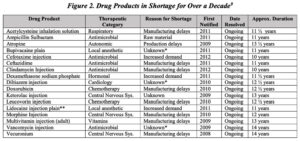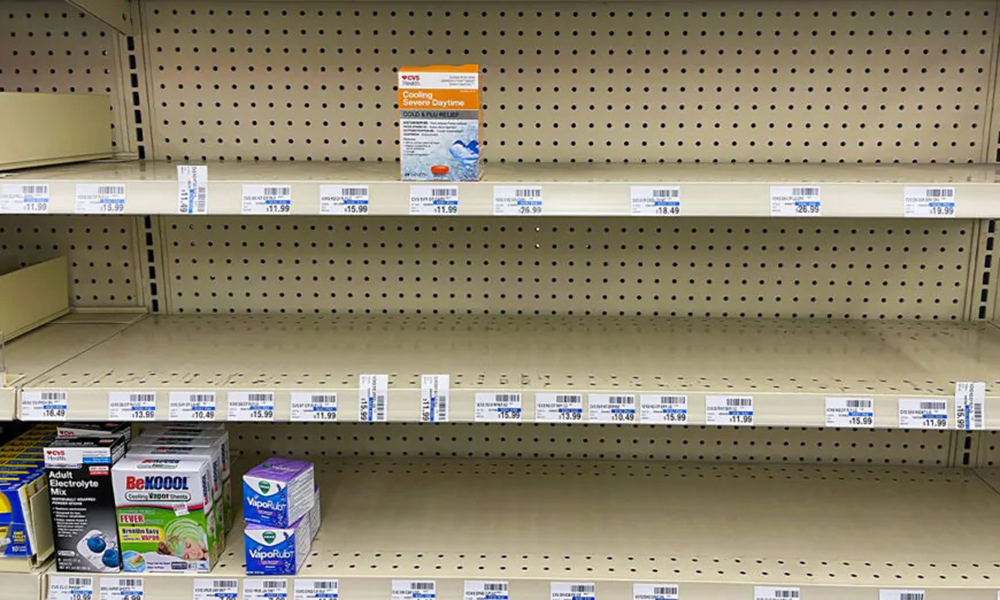|
Getting your Trinity Audio player ready...
|
By: Vance Voetberg
According to a recent Senate report (pdf), drug shortages increased to nearly 30 percent between 2021 and 2022.
“Drug shortages are increasing, lasting longer,” the Senate report said. “The number of active drug shortages in the U.S. reached a peak of 295 at the end of 2022.”
Though drug shortages are not uncommon, the current shortage is sparking renewed interest among lawmakers. “Congress, the executive branch, and industry must work together to respond to this decades-long problem,” the report remarked.
Doctors Lack the Most Effective Medicines
From basic asthma medication to certain chemotherapies, doctors are finding it increasingly challenging to acquire the medicine they need to treat patients. The shortage places doctors in complicated positions of prioritizing certain patients’ needs above others, thereby imposing increased ethical burdens on health care professionals.
In a 2022 study published in the American Society of Oncology’s JCO Oncology Practice journal, 75 percent of oncologists could not prescribe the preferred chemotherapy agent due to shortages. When the preferred chemotherapy treatment isn’t available, doctors are forced to choose less effective alternatives, delay treatments, or reduce treatment dosages.
“Surprisingly,” wrote Yoram Unguru, an assistant professor of oncology at the Johns Hopkins Kimmel Cancer Center, “Little formal guidance exists to help oncologists make these tragic choices. Should we prioritize lifesaving chemotherapeutics, and if so, what criteria should we employ? Should children receive preference over adults? Perhaps patients with a better prognosis deserve priority access?”

Oncologists are not the only doctors facing difficult medical decisions.
Commonly used drugs like albuterol, used when asthma patients experience life-threatening asthmatic attacks, are also in shortage. Amoxicillin, a generic antibiotic widely used to stop the spread of pneumonia, is needed. There’s a scarcity of epinephrine, a medicine used when individuals experience severe allergic reactions. Children’s cold and flu medicine is also sparse.
“The majority of these medications are relatively simple to make and have been available for decades. How is it that they are unavailable in the United States—the wealthiest country in the history of human civilization?” testified Dr. Alex Oshmyansky on May 11 in front of Congress’ Subcommittee on Oversight and Investigations, which is investigating the root cause of drug shortages.
“The rates for morbidity and mortality for pediatric cancers in the U.S. have gone up in recent years, as the medications necessary to treat them are increasingly unavailable,” Oshmyansky told Congress.
Profit-Driven Motives?
While the reasons for the drug shortages are multifactorial, such as production malfunctions or insufficient raw materials, “the overarching theme is that almost all of these products are low-cost generic sterile injectables with low-profit margins. This means manufacturers have little incentive to invest in process upgrades, expanded capacity, or redundancy in production facilities,” said Dr. William L. Dahut, chief scientific officer for the American Cancer Society.
“Companies make business decisions to discontinue manufacturing certain drugs, particularly generic drugs, based on profitability or other business considerations without always ensuring the continued manufacture of the drug elsewhere,” he told The Epoch Times.
The pharmaceutical industry doesn’t generate the desired profits it is seeking by creating common drugs, even though they are in high demand. Instead, what produces higher profits are newer drugs.
In February, due to bankruptcy, Akorn Pharmaceuticals, a drug company solely focused on making generic drugs, was forced to shut down all U.S. operating sites. Akron was the sole manufacturer of a particular form of albuterol used in hospitals for patients with serious respiratory complications.
“It’s important to note that these products are manufactured by private companies, and the FDA cannot require a pharmaceutical company to make a drug, make more of a drug, or change the distribution of a drug,” the U.S. Food and Drug Administration (FDA) wrote on Twitter in response to Akorn’s closure.
Because it’s outside of its statutory powers, the FDA doesn’t have the authority to compel drug companies to upregulate production. Democrats and Republicans are united in attempting to provide a solution to drug shortages. The solution, however, is far from simple, given that the authority of agencies like the FDA is a contentious topic among lawmakers.
But as the Senate’s report on drug shortages pointed out, neither the industry nor the federal government has end-to-end visibility of the pharmaceutical supply chain. “This lack of transparency limits the federal government’s ability to proactively identify and address drug shortages,” the report said.
The Problem With Pharma Middlemen
In Thursday’s hearing, Rep. Morgan Griffith (R-Va.) drew attention to the controversial practices of pharmaceutical middlemen. Middlemen are group purchasing organizations (GPOs) and pharmacy benefit management (PBM) firms that negotiate drug rebates and fees, create drug formularies and surrounding policies, and reimburse pharmacies for patients’ prescriptions.
They are the link between pharmaceutical and insurance companies that have “enormous influence over the U.S. prescription drug system,” said Federal Trade Commission Chair Lina M. Khan in a press release.
“Middlemen,” Griffith said, “Do not care to look for ways to mitigate shortages.
“The four largest group purchasing organizations control 90 percent of the medical supply market and have massive market power. They could help end drug shortages by prioritizing generic drugs’ availability and quality. Instead, they use their market power to force ‘race-to-the-bottom’ pricing without consideration for quality or availability.”
The questionable methods of middlemen have grown under scrutiny to the extent that the Federal Trade Commission launched an inquiry in June 2022 to investigate their impact on the accessibility and affordability of pharmaceuticals. Initially, the inquiry included the six largest BPMs in the United States, but as of this past Wednesday, the commission included two more PBMs that will be required to provide information and records of their business practices.
“The largest PBMs are integrated with the largest health insurance companies and wholly-owned mail-order and specialty pharmacies. They influence which drugs are prescribed to patients, which pharmacies patients can use, and how much patients ultimately pay at the pharmacy counter,” the Federal Trade Commission said on Wednesday.
While not providing a date for when the inquiry will release its finding, the commission’s inquiry “is aimed at shedding light on several PBM practices.” But for now, it appears the solutions to end drug shortages remain in the dark.



